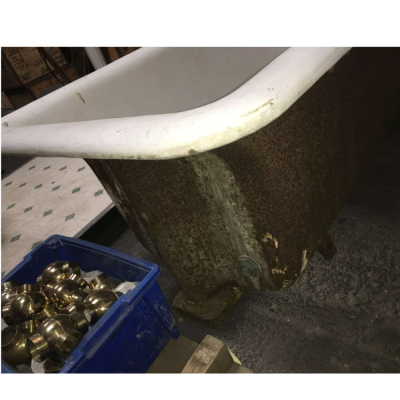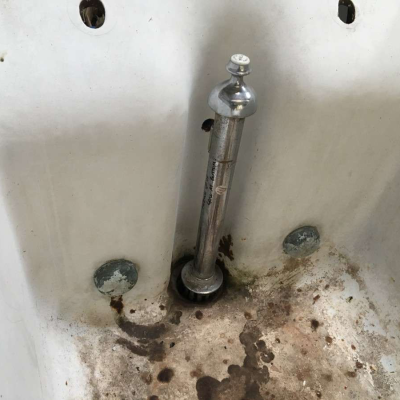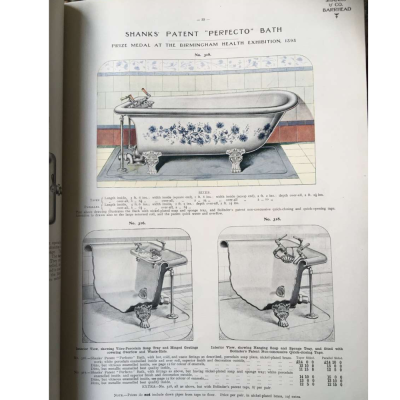Antique Cast Iron Roll Top Bath. ENORMOUS. From a museum. Very rare, c.1905.
£ 650
Quantity in stock: 1
Very rare HUGE roll-top bath, made c. 1905 by Shanks & Co. of Barrhead, Scotland.
Length: 80 inches. Width: 34 inches. Height: 29”.
(Metric: 203 x 86 x 74 c/m).
Requires full restoration; I can put the successful buyer in touch with firms who can do the work.
‘Silent-fill’ or ‘Steamless’ tap spouts.
The bath’s feet are the rarest and best of Shanks’s designs.
DESCRIPTION:
A very rare original period bath of the ‘country house’ type: this one being six feet eight inches long is likely to have come from a great house, a stately home or even a castle or palace. Made of cast iron, it is very long, very wide, very deep and very heavy.
Until recently this bath was an exhibit in the former Thomas Crapper Museum, a private collection of antique sanitaryware. See statement at the end for more details.
Please note that I would say it is not a restoration job for an amateur. Naturally I will help the purchaser in any way I can.
DESIGN:
The manufacturer was John Shanks & Co. Ltd., the best of the Scottish companies and one of the best in the world. The pattern of the bath is a variation on the classic British design of the Victorian/Edwardian period; an expensive type of bath which was generally seen in large rectories, mansions and country houses. Typically that type of bath was around six feet long, sported extra-large bath taps and had a ‘plunger’ waste (more properly called a ‘standing waste’). This bath is bigger than even a classic Country House bath and it was even more expensive at the time. The tap heads were mounted on the 45 degree-angled end of the bath: they were just valves with tap heads: no spouts, as the water emerged from the metal domes either side of the waste near the bottom of the tub. This was to reduce noise and steam when drawing a bath.
This particular design was introduced in the late 1890s but I would say this example dates from around 1905. See the photograph of a page from the Shanks trade catalogue of 1899. The other catalogue page I have included is one by a plumbers’ merchants who were offering this very bath, but with the unusual taps with the straight spouts. That catalogue is undated but appears to be about 1905.
The standing waste was introduced so that the diameter of the plug-hole could be increased, allowing one to drain such a large bath in short order. The Victorians found that fitting a huge plug and chain in a large-diameter waste was not very practical, as the weight of a full bath of water on the plug’s large surface-area made it difficult to pull out.
In its day, this type was the most desirable of bathtubs. In his biography of Thomas Crapper, 'Flushed with Pride', Wallace Reyburn says of the great man: ‘…naturally he would have the best, including a bath which didn't have a plug but instead a pull-up waste pipe, which was the thing in those days.’
As with the very best of these baths, in this case the standing waste is set into a recess, out of the bather’s way. This is comparatively rare due to a more complex (therefore expensive) casting process, but the most remarkable thing about this particular bath is its sheer size.
CONDITION:
Although the cast iron base material of the bath is in sound condition as per the images, it would require re-surfacing or re-enamelling prior to being put back into service. I can suggest a suitable firm to undertake either process.
When restored, if it were on sale in a specialist’s shop this bath would be priced around £9,000.
DIMENSIONS:
80 inches long; 34 inches wide; 29 inches high, when feet are fitted.
(Metric: 203 c/m; 86 c/m; 74 c/m).
TAPS AND WASTE FITTINGS:
The ‘noiseless and steamless’ tap spouts are still attached but the tap heads and valves have been lost. The restorers I can suggest to you will be able to provide modern replacements, or restored originals.
Alternatively, please see the chrome taps featured in some of the photographs: this unusual design was an option at Shanks’s back in the 1890s. The steamless spouts could be removed and the holes stopped up, then these taps could be installed on the angled surface for which they were designed. This pattern of tap is very rare so if required they would be available at an extra cost of £300.
The standing waste is not original to the bath but it is appropriate in period and scale for a bath of this kind. To work properly a professional restorer would need to adapt the plunger to fit. I can put you in touch with suitable people; alternatively just fit a big plug and chain.
SUPPORT:
I have over 40 years’ experience in the restoration of antique sanitaryware so I can advise you on how best to do all the work: alternatively I can suggest whom you could employ to have some or all of the work done for you.
VIEWINGS:
Do contact me if you would like to view the bath in person. Please see my other listings of rare antique baths, which I will be adding to over the next few days and weeks.
In addition I have hundreds of original antique loos, washbasins, taps, cisterns, trade catalogues, framed pictures and advertising which I will not find time to list individually, but potential purchasers are welcome to come to see what is available.
The bath and the other contents of the former Crapper Collection are stored just outside Stratford upon Avon, Warwickshire. It is on ground level with good vehicular access. This piece is very heavy; a van with a tail-lift is recommended. I regret I have badly damaged my back so I am unable to assist with lifting the bath. I have a trolley which we can use to wheel the bath outside and up to your van.
FROM THE FORMER THOMAS CRAPPER MUSEUM:
This is just one item from what was once the largest collection of antique sanitaryware in the country; perhaps anywhere. For many years I owned and ran the famous old firm, Thomas Crapper & Co., established in 1861. When I sold the business nearly ten years ago I retained what used to be the company museum.
Mostly assembled in the 1980s and 1990s, it was a private collection which was seen by relatively few customers and people in the trade. It comprised loos, basins, baths, cisterns, taps, accessories, trade catalogues, salesman’s samples and advertising ephemera; all by many different manufacturers, including Shanks, Bolding, Twyfords, Doulton, Jennings and Crapper to name a handful.
After extensive efforts failed to find a buyer for the whole Thomas Crapper Museum I am dispersing the contents.
It is an opportunity never to be repeated!
Please note this is not a business, I am selling the contents of my museum.
- Business Name:George Jennings Ltd
- Contact Name:Simon Kirby
-
Location:
Warwickshire
>
UK
07590 189 410
- Category: Bathroom & Accessories
- Age: More than 50 years old
- Listing ID: 40878
- Date of listing: 16-06-2025
- Date last updated: 16-06-2025
Salvo is the original architectural salvage & reclamation marketplace. Subscribe
to SalvoNEWS

























